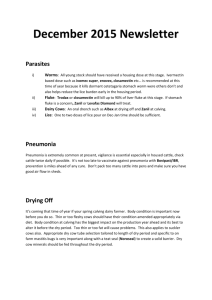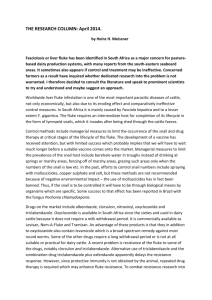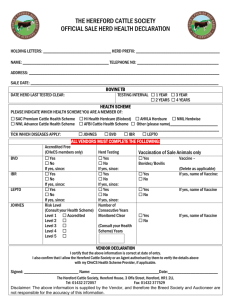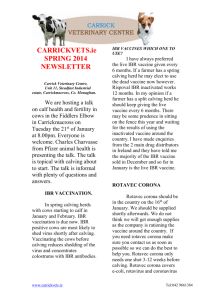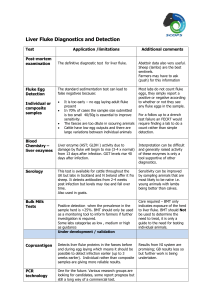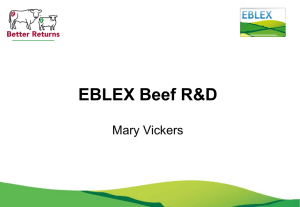WORMING - Carrickmacross Veterinary Centre
advertisement
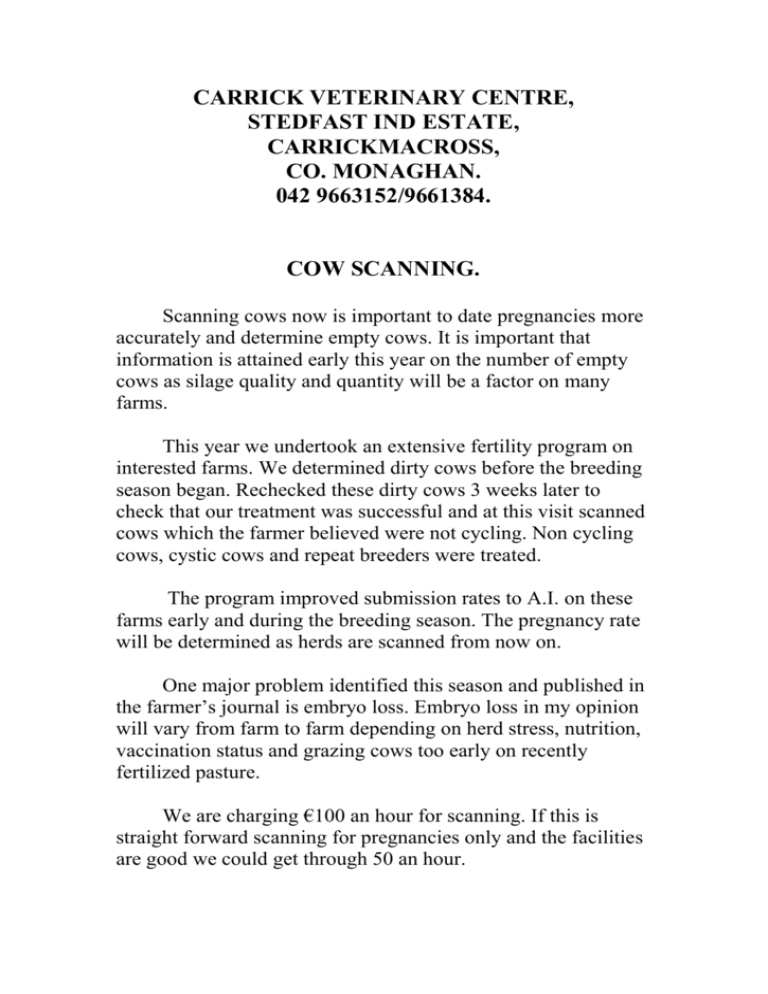
CARRICK VETERINARY CENTRE, STEDFAST IND ESTATE, CARRICKMACROSS, CO. MONAGHAN. 042 9663152/9661384. COW SCANNING. Scanning cows now is important to date pregnancies more accurately and determine empty cows. It is important that information is attained early this year on the number of empty cows as silage quality and quantity will be a factor on many farms. This year we undertook an extensive fertility program on interested farms. We determined dirty cows before the breeding season began. Rechecked these dirty cows 3 weeks later to check that our treatment was successful and at this visit scanned cows which the farmer believed were not cycling. Non cycling cows, cystic cows and repeat breeders were treated. The program improved submission rates to A.I. on these farms early and during the breeding season. The pregnancy rate will be determined as herds are scanned from now on. One major problem identified this season and published in the farmer’s journal is embryo loss. Embryo loss in my opinion will vary from farm to farm depending on herd stress, nutrition, vaccination status and grazing cows too early on recently fertilized pasture. We are charging €100 an hour for scanning. If this is straight forward scanning for pregnancies only and the facilities are good we could get through 50 an hour. CATTLE DOSING. Dosing of cattle this summer has been hit or miss on many farms. It is crucial that action is taken soon as high fluke and worm burdens can become evident in cohorts of cattle leading to rapid weight loss and animals more prone to infectious diseases such as viral pneumonia. It is important to choose the right product based on the age profile of the animal, dosing frequency during the summer and the dampness of the ground. The definitive dose for fluke is given after housing as cattle are reinfected with fluke after dosing if they are still on grass. If cattle are not being housed until November it would be advisable to fluke dose now and again after housing. Closamectin or closivet is a good idea now. It has the same ‘spec’ as ivomec and in addition it has a flukacide that kills from 6 week old fluke upwards. This will kill 2 out of 3 stages of fluke and it because it has a residual killing effect it will stunt a proportion of the remaining fluke it leaves behind. Tribex, endofluke and fasinex kill all stages of fluke. It can be given from two week housed. It will kill 90% of all fluke from 2 weeks housed. A wormer needs to be given with this product. Pfizer has launched a new wormer called cydectin triclamox pour on. It contains a wormer which works for 10 weeks and a flukacide that kills all stages of fluke. A teething problem with the drug is that the withdrawal period is 143 days. This will fall dramatically next year. Cydectin pour on works for 10 weeks. It has the same ‘spec’ as ivomec. It has a milk withdrawal of 4 days. It originally had a zero milk withdrawal in France. Cydectin like dectomax is great at killing lice due to it’s 10 week action. We have a wide range of dosing at great ‘pay on the day’ prices. We have negotiated these prices with our suppliers for the autumn season. We are passing these savings on directly to our customers if they pay on the day. Some examples of our great prices are quoted below. ENOVEX 500 ML INJECTION FOR €30. ENOVEX 2.5 LITER POUR ON FOR€50. CLOSAMECTIN 500MI INJECTION FOR €75. CLOSAMECTIN 5 LITER POUR ON FOR€500. CYDECTIN 2.5 LITER POUR ON FOR €145. VACCINATING WEANLINGS. We advise giving weanlings one shot of IBR live and one shot of rispoval intranasal live to homebred cattle one month before housing. Bought in weanlings should be given the vaccination at day of purchase intranasally. WET WEATHER BLUES!!! Not since 1985 have we witnessed such a wet summer. This can affect cattle health. We are noticing a lot of coughing calves, scouring cows and tetany this summer. The coughing calves are caused by lungworm and viral pneumonia this summer. Calves coughing with lungworm tend to stretch out their necks protrude their tongue and cough. When they are at this stage illthrift is becoming apparent. However this summer we are also finding calves with high temperatures, empty, dull with perhaps a cough. This is principally IBR pneumonia brought about by the stressful weather conditions. Fluke will be a big problem this back-end. We are seeing a lot of scouring cows with bubbles in the dung. Fluke burdens are directly related to snail numbers which in turn is directly related to the level of rainfall. Closamectin given now as part of a routine dosing regime would be beneficial. Closamectin has the same ‘spec’ as ivomec for lungworm and stomach worms and in addition kills immature fluke and adult fluke. It also has a residual killing effect and will therefore stunt early immature fluke. The rationale for using it is simple it will wipe two out of the three stages of fluke in the animal at time of use and further stunt a proportion of the early fluke remaining at time of dosing. Fluke burdens will be reduced at the backend and should be tackled again. I would even go as far as dosing yearlings for fluke now during this July. Closamectin is available as an injection or pour on. The injection is cheaper than the pour-on. We have great value in closamectin particularly the injection. There is a new competitor to closamectin only available to vets called closivet. If there are cattle still scouring after treatment give these cattle zanil or levafas diamond for rumen fluke. Cydectin has the same ‘spec’ as classic ivomec but kills for twice as long ie.10 weeks. Dectomax is not available this year. Soil ingestion when cattle are cutting teeth is the primary reason for listeriosis. Listeriosis is a form of meningitis. The bacteria are in the soil and passes around the inflamed gums. The bacteria then follows the nerve of the tooth back to the brain. Since one half of the brain is affected the animal looks like it has had a stroke. The animal has a head-tilt and may circle to one side. There may be saliva falling from the mouth. EPRINEX Dairy cows are restricted to eprinex pour-on whilst milking. There is scientific evidence that dosing with eprinex will increase milk yield marginally but over a sustained period of time. This effect in larger numbers of cows can be worth several thousand euros and the herd’s fertility marginally improves after using eprinex. IBR VACCINATION. The six monthly IBR vaccination is due if you have a spring calving herd with calving starting in January. Pfizer has announced that their dead inactivated rispoval IBR vaccine lasts 12 months. In my view if you are going to switch from a live to a dead vaccine use it in December if your cows are calving in January. There are differences between live and dead IBR vaccines. The live vaccine has a segment of DNA missing from a field strain of virus. The vaccine can replicate in the vaccinated animal and be passed onto unvaccinated animals. The vaccine causes no disease and provokes a strong immunity in the animal. The dead vaccine does not replicate inside the animal and does not pass onto other animals. The live vaccine stimulates cell mediated immunity were the dead vaccine stimulates humoral immunity. Live vaccines should always be used in bought in animals, young calves, in face of an outbreak and were vaccination has been started for the first time. I am an advocate of the Scandinavian model in relation to IBR eradication. They generally use a live IBR vaccine every 6 months for 4 years and then switch to a dead vaccine. The dead vaccine can now be used annually one month prior to calving starting. The Scandinavian model is based on a closed herd. The use of dead IBR vaccine should only be used in negative BVD herds. BVD virus circulating in IBR positive herds can cause immunosuppression of the animal leading to a poorer response to the dead IBR vaccine. IBR vaccine can be purchased at around €2.50 per cow based on payment on the day. IBR vaccine is available in 10 and 50 dose packs in the rispoval range and there is a 5 dose pack in the bovilis range.

